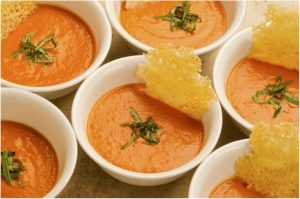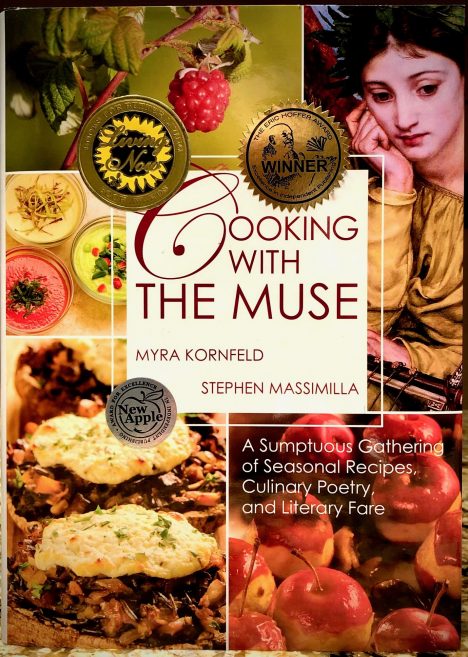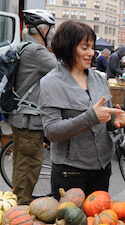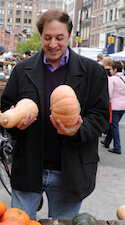Cooking with the Muse
by Myra Kornfeld and Stephen Massimilla
$39.95
“[A]n education, invitation, and testament to the peregrine splendors of human hungers of every kind—for dishes and flavors, for knowledge and history, for the transformations and sustenance that both cooking and literature bring.” —Jane Hirshfield
Format: hardcover
Out of stock
“[A] culinary-reader of delights nested together much like a matryoshka doll. With hundreds of recipes, poetic prose pieces, cooking and poetry notes, and lavish illustrations, this literary-cookbook defies simple classification. Authors Myra Kornfeld and Stephen Massimilla offer a lap-filling volume that could be criticized for overreach if it weren’t such a fascinating genre-blending, seasonally-framed journey through history and culture.” — Susan Thurston, Los Angeles Review
“Cooking with the Muse shows how poetry and food are connected by the cycles of nature, the seasons, the landscape: the stuff poets write about…Stephen Massimilla, a professor and accomplished poet, brings much of his own work to the party… Myra’s banquet of original and sumptuous recipes speaks to the poet in all of us.” — Rozanne Gold, The Huffington Post
“When writing a cookbook, one of the challenges is to curate recipes that will be universally appealing. The authors have more than met expectations in this regard. They take their inspiration from cuisine that hails from around the world, as well as dishes that epitomize Americana. The recipes are approachable for novice cooks and avid chefs alike. Perhaps even more impressive are the irresistible poems and passages. They make it all but impossible to thumb through quickly in search of a recipe, as one’s eye is instantly drawn to the texts. This well-crafted cookbook would make an enviable addition to any kitchen.” — Jacquelyn Gilchrist, Recommended Review, The US Review of Books
“Kornfeld and Massimilla were going to write a cookbook; they made a kind of poem instead. Here are historical discussions, contemporary observations; course corrections… analyses of fats such as butter, and of K2 (the vitamin, not the mountain); and the sundry ways and means of the culinary arts. Massimilla…put together a collection of his astonishingly original poems on food… With its wealth of detail and its numerous ways of approaching food, this book must surely have been a labor of love.” — John Paul Russo, Editor-in-Chief, Italian Americana
“Chef Myra Kornfeld and poet Stephen Massimilla are the authors of Cooking with the Muse (Tupelo), a book that presents food with a side of poetry. Kornfeld and Massimilla expound on recipes and culinary poetry, such as John Milton’s lines on fennel from Paradise Lost, ‘[A] savoury odour blown / Grateful to appetite, more pleased my sense/ Than smell of sweetest Fennel,’ paired with a Butternut Squash, Pear, and Fennel Soup with Fennel Oil and Blue Cheese!” — Publishers Weekly
“The table of contents of Cooking with the Muse reads like poetry: Braised Sunchokes with Fennel, Olives, and Thyme; Warm-Hearted Pea Cakes with Sesame Crust and Garlic-Piquillo Pepper Sauce; Mango Chia Seed Pudding with Cashew-Coconut Cream…. These are words that roll gently around the tastebuds, as well as the imagination. The authors freely intersperse recipes with historical and artistic references, lore and verse to inspire your culinary liaison. The richness of the text ensures the recipes will nourish soul as well as body in this love affair between food and literature.” — Whole Life Magazine
“Some are so moved by the poetic nature of food and cooking that they’ve written a whole cookbook inspired by the relationship. Cooking with the Muse by Myra Kornfeld and Stephen Massimilla explores poetry and cooking by pairing fantastic recipes with thematic verse. One of our favorites is a celebration of spring onions—perfect for this time of year.” — FOOD 52
“Muse casts a wide net into deep waters, submerging the reader into an ardent exploration of an ingredient through its historical roots — such as tracing Brussels sprouts’ popularity during the late Renaissance, paired with a recipe for Shaved Brussels Sprouts with Caramelized Shallots and Grana Padano Cheese. A single line of poetry can offer the cook inspiration, as evidenced in Osip Mandelstam writing ‘And I was alive in the blizzard of the blossoming pear’ (Christian Wiman translation). Who wouldn’t then want to spoon into warm from the oven Apple-Pear Cranberry Crumble? “ — Annelies Zijderveld, Poetry International
“I believe cookbooks can be pleasurable respites and inspiring tools to help you actually feel as if you have more time in your day. No better place to look than the dense book lover’s cookbook, Cooking with the Muse: A Sumptuous Gathering of Seasonal Recipes, Culinary Poetry, and Literary Fare by Myra Kornfeld and Stephen Massimilla, for pure delectable inspiration. Far more than a cookbook offering quick and tasty meals, this wonderfully curated and carefully organized resource is a delightfully poetic read.” — Emily Walter, Colorado Review
“Though it is certainly more cookbook than poetry anthology, Cooking with the Muse still manages to embody poetry even on pages where no actual poems are present, and is an excellent addition to the poet’s kitchen and the cook’s library alike.” — Caitlin Pryor, Pleiades
“Cooking with the Muse … leaves the reader exulting in every meal they remember relishing, connecting the experience—of shopping for groceries, preparing a mise en place, simply stirring a soup or stew, of spooning the first hopeful bite into your mouth, and then the quiet and happy-sighing meal that followed—of food with something both historic and lyric.” — Chloe Anne Campbell, storySouth
“Getting to Know Stephen Massimilla, Myra Kornfeld, and their new book Cooking with the Muse” — Mass Poetry
“What sets this book apart is the added literary component of culinary poetry on food, cooking and eating, making it my pick as the best cookbook of the summer.” — Diane Worthington, The Chicago Tribune
“A great cookbook is meant to be devoured as much while reading on the couch as while pacing in the kitchen; a great poetry anthology is an inspiring by the stove as in the living room. Cooking with the Muse: A Sumptuous Gathering of Seasonal Recipes, Culinary Poetry, and Literary Fare, a compendium of 150 recipes, 200 full-color photographs, poetry about food and cooking, culinary and historical notes, and literary notes is at home in every room of the house, the stuff of dreams and of action, thinking and making.” — Grace Dane Mazur, Artsfuse.org
“This creative and vibrant effort marries two highly imaginative endeavors.” — Barbara Jacobs, Booklist
“Get good ingredients a French chef might say, and try not to screw them up. The heart of this big beautiful book beats with that philosophy, but also this: respect the food, and please, slow down, and don’t forget to read some poetry along the way.” — Josh Cook, Foreword Magazine
“If I ever had the chance to take off a year and spend it in the country with my family, the one cookbook I’d pack is Cooking with the Muse. Preparing recipes from this book will persuade you to slow down and appreciate the powerful connection between food, poetry, and nature. Come to think of it, wherever you are–enjoying the fantasy vacation of your dreams or anchored to herth and home–Cooking with the Muse will provide you with a tasty new seasonal recipe, and poem, every night.” — Sara Moulton, Chef, Cookbook Author, Television Personality
“This vertiginous, seductive, learned book surprises the palate on every page. Its ranging, awakening recipes and awakening, ranging poems would be more than enough to satisfy any cook or reader. The added notes, though… These are an education, invitation, and testament to the peregrine splendors of human hungers of every kind—for dishes and flavors, for knowledge and history, for the transformations and sustenance that both cooking and literature bring. The only dilemma is where to shelve this—in the kitchen among the cookbooks, or in the library next to Dickinson, Hopkins, and Heaney.” — Jane Hirshfield, Poet, Essayist, and Translator
“A sensual chef-d’oeuvre of culinary prowess seasoned with the cultural notes of poetry and nutritional wisdom–you will savor every page of this holistic masterpiece.” — Kathie Swift, Leading Nutrition Author and Speaker
“I have fallen in love with Cooking with the Muse. What a treasure trove of recipes, poems, quirky and fascination literary references and reflections on food and its meaning in our lives. I don’t knowwhen a cookbook has been such a good read! I find myself underlining my favorite bits, like this from Lucile Clifton: ‘I taste in my natural appetite/the bond of live things everywhere.’ I want to give this book to every poet and cook I know.” — Ellen Bass, Poet and Teacher
“Delicious and captivating–the perfect source of inspiration–literary and culinary arts. What a great gathering of the gifts of poetry and cooking!” — Barbara Sibley, Co-Founder of the San Miguel Poetry Week and Chef-Owner of La Palapa Restaurant
“Part love song, part practicum, part history lesson, Cooking with the Muse is a delightful page-turning compendium heralding the life-giving joy of cooking with the seasons.” — Mary R. Cleaver, The Cleaver Company, The Green Table, Table Green at the Battery
“Prepare your appetites! This glorious compendium of recipes, food lore, poetry, and history offers savory layers of enjoyment in every category — It’s a delicious feast of love.” — Naomi Shihab Nye, Poet and Novelist
“Cooking with the Muse is a book I want to cuddle up with in bed until it becomes tattered and splattered.” — Liz Lipski, PHD, Author of Digestive Wellness, Director of Academic Development Nutrition Programs, Maryland University of Integrative Health
“Cooking, like any other art, requires the Muse. She leads us down misty paths of green herbs, tantalizes us with the smells from a simmering cauldron, drizzles sweet rosewater dew on our tongues. Alas, all too often, the Muse escapes us, and we experience a culinary cul-de-sac. In this mouth-watering book, Kornfeld and Massimilla generously mix rich poetry and prose, irresistible recipes, vibrant photographs, and timeless nutritional wisdom to reaswken the sleeping Muse within us. She entices us back to the kitchen, whispering in our ears the long-forgotten names of beloved flavors, inspiring us on every level: to listen, to taste, to celebrate, to cook, to love, and to eat.” — Jessica Prentice, Co-Founder of Three Stone Hearth Community Supported Kitchen
“A golden idea comes to the table in Cooking with the Muse. Of course there is poetry in cooking! Recipes even look like poems–the lines distince and the outcome magically blended. Literally delicious, Cooking with the Muse delights, entices, comforts and enthralls. Each dish is a poem in itself.” — Molly Peacock, Poet, Author, Speaker
“Cooking with the Muse not only guides you through the seasons showing you how to make inspired dishes with global flavors; it does so with wordsof poetic inspiration, providing a multicultural view of the pleasures of cooking and eating. Cooking with the Muse offers a combination that satisfies both stomach and soul.” — Richard Ruben, Seasons to Taste, LLC, AUTHOR, The Farmer’s Market Cookbook
Winner of the 2017 Eric Hoffer Book Award
Winner of the 2017 National Indie Excellence Award in Cookbooks
Winner of the 2017 Living Now Book Award in Cookbooks
Winner of the 2017 Independent Author Network Book of the Year Award in Nonfiction
Winner of the 2017 Beverly Hills Book Award in Cookbooks
2017 Next Generation Indie Book Finalist Award (NGIBA) in the COFFEE TABLE BOOK / PHOTOGRAPHY category
2017 International Book Award Finalist in Cookbooks
2016 USA News Best Book Finalist Award in Nonfiction and Poetry
2016 Winner: the New England Book Festival Award in Cookbooks and Nonfiction
Cooking with the Muse offers 150 nutritious international recipes with a plenitude of imaginative poetry about food and ingredients, along with enlightening literary essays, playful culinary and historical notes, and 200 beautiful full-color photographs.
- Highlights fresh, local ingredients and encourages the use of seasonal produce, wild seafood, traditional fats, and healthy meat from pasture-raised animals.
- Revels in flavors that are complex and global, ranging from Middle Eastern and Turkish to American Southwestern, from Vietnamese and Japanese to Italian and Indian.
- Offers a delectable feast for the locavore or omnivore, novice cook or experienced chef — a food lover’s literary anthology and a poetry lover’s cookbook.
“[A]n education, invitation, and testament to the peregrine splendors of human hungers of every kind—for dishes and flavors, for knowledge and history, for the transformations and sustenance that both cooking and literature bring.” —Jane Hirshfield
“I don’t know when a cookbook has been such a good read! … I want to give this book to every poet and cook I know.” —Ellen Bass
Additional information
| Weight | 7 lbs |
|---|---|
| Dimensions | 9 × 6 × 2 in |
Excerpt

Tuscan Roasted Tomato Soup with Parmesan-Gruyère Frico
Soup
- 2 cups thin sauté-sliced onions
- 2 1/2 pounds tomatoes
- 4 garlic cloves, peeled
- 1/4 cup extra virgin olive oil
- Salt
- 2 cups vegetable stock
- 2 tablespoons long-grain white rice
- 1/2 cup roughly chopped fresh basil
- Freshly ground black pepper
Parmesan-Gruyère Frico
- 2 ounces Parmesan cheese, grated on the large holes of a box grater
- 2 ounces Gruyère cheese, grated on the large holes of a box grater
- Preheat the oven to 375°F.
- Lay the onions in an 8 by 11-inch baking dish. Core and quarter the tomatoes and lay them on top of the onions. Distribute the garlic around the tomatoes, drizzle the oil on top and sprinkle with 3/4 teaspoon salt. Bake for 45 minutes, until the tomatoes are shriveled.
- Transfer the onions, tomatoes, and garlic with all of the accumulated juices to a blender and buzz until smooth.
- While the tomatoes are roasting, add the rice to the stock in a medium pot and bring to a boil. Lower the heat and simmer, covered, until the rice is cooked, about 15 minutes.
- Transfer the rice and stock to the blender with the tomatoes and buzz everything together until smooth. Return the soup to the pot and set aside.
- Make the fricos: Mix together the cheeses. Sprinkle a 3-inch disk of cheeses in a nonstick skillet over medium heat, overlapping the shreds of cheese so that they can melt together; but don’t pile them too thick. If your skillet is large, you may be able to make a few of these at the same time. Cook until the cheeses are melted, bubbling, and golden; turn off the heat.
- When the frico is cool enough to touch, a minute or two after the bubbling has slowed, lift it and transfer to a plate. Continue making the fricos until there is no more cheese. (You should have 10 to 12 in total.)
- Bring the soup to a boil, then lower the heat and simmer for 10 minutes to marry flavors.
- Add the basil and a sprinkling of pepper, and simmer for 5 minutes more. Taste, and add a pinch more salt if necessary.
- Serve the soup hot, with one frico sticking out of the soup like a fin and one on the side.
Poet’s Note
Tomatoes were cultivated many centuries before Christ. Even though tomatoes originated in South America, it was not the Incas but the Mayas over 1000 miles to the north who first took interest in them. The word “tomato” derives from the Nahuatl word tomatl. The Pueblo people associated the ingestion of tomato seeds with the power of divination.
Though Cortés and company brought tomatoes back to Europe, they took a while to catch on there too. There is no mention of them until 1544, when the Italian botanist Mattioli named a yellow tomato pomo d’oro (“golden apple”); the Italian word for any tomato is still pomodoro. It was also known by a series of more derogatory nicknames, such as “wolf peach,” until it was dubbed the “apple of love” in the late 16th century. It is said that the French mistook the term pomo d’oro for pomo d’amore.
The first real culinary mention of the tomato in Italy was in 1548, when the house steward of Cosimo de’ Medici, the grand duke of Tuscany, wrote with relief that the basket of tomatoes sent from the duke’s Florentine estate had arrived safely. The Tuscans had a head start in developing good tomato recipes, and that’s why we’re featuring a Tuscan-style Roasted Tomato Soup.
Tomatoes were first eaten by Europeans in what we now call salsa, a dish originally developed by the Aztecs. Perhaps because they were called “love apples,” American Puritans considered tomatoes an abomination. Hundreds of years later, most Americans still considered them poisonous. It wasn’t until the mid-19th century that tomatoes brought back to America by Italian immigrants really caught on; we owe their ubiquity to the popularity of Italian food and to the breeds developed by Alexander W. Livingston.
Diachronic Tomato
Forget the pink-speckled
pickled moon.
On the table beaming
into mouth-moistening
summer, who favors
the heirloom
genuflects, traces
its litmus: time for
the sun’s red fruit.
I split this globe—
the popped seeds,
spurt of stars in
the evening air,
echoing the glittering
day, the sea
of heated leaves,
the stems fuzzed and hot
as the simmering noon,
slosh of olives
and basil in the pot,
enemy of snow,
the tomato,
high esteem of the vine,
the ripened eye,
the sun-red bite,
juice glimmering
on our lips,
the happy murder,
what we cannot
even speak,
molten hemispheres
of bleeding flesh
in their skins.
—Stephen Massimilla



